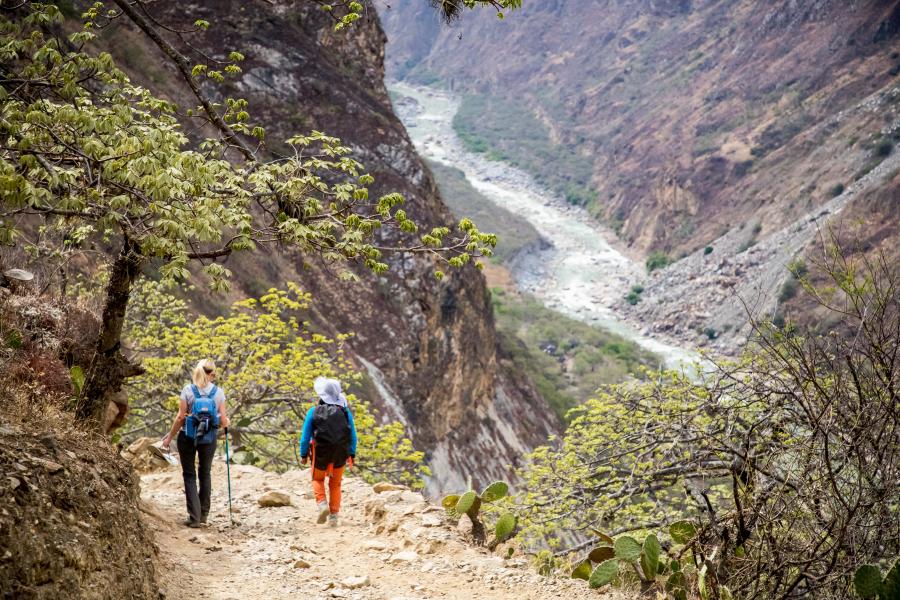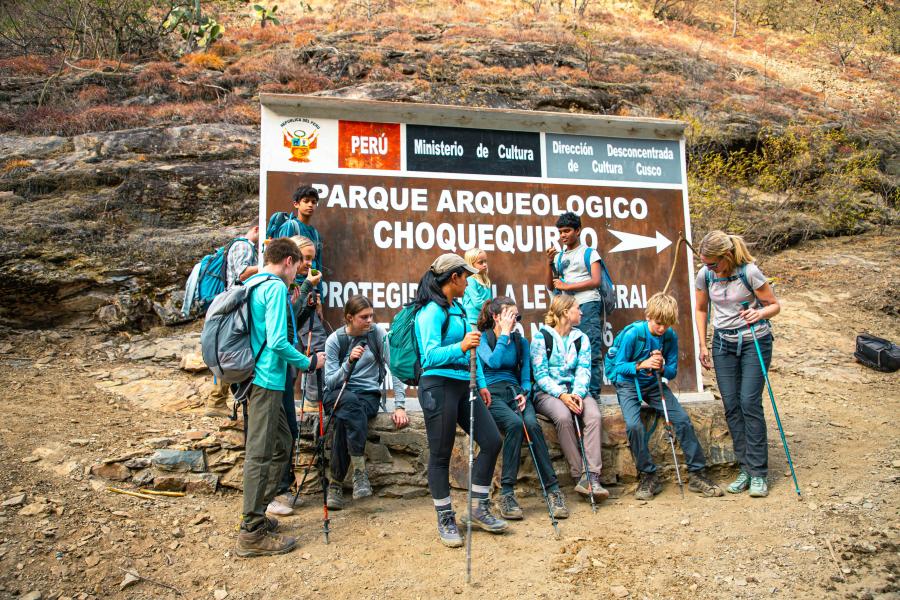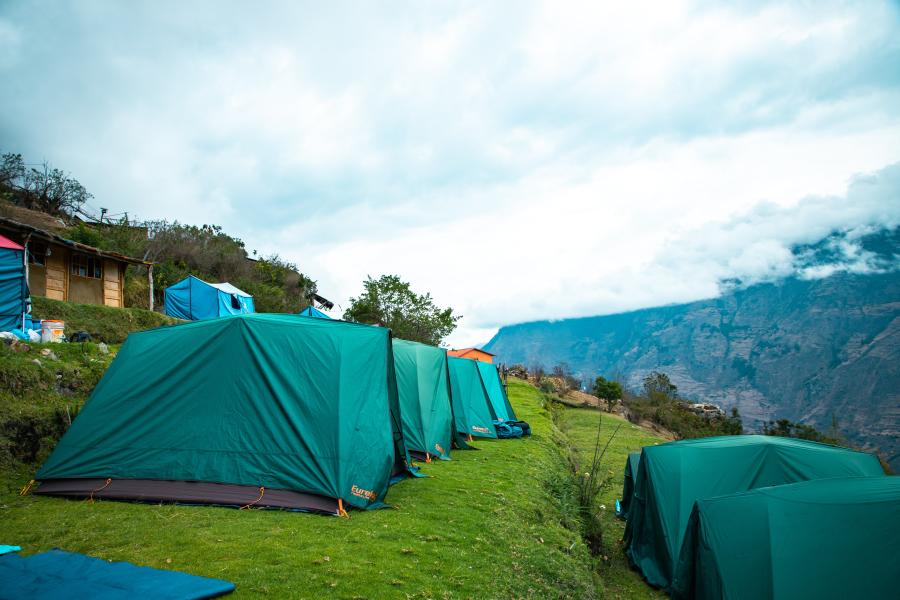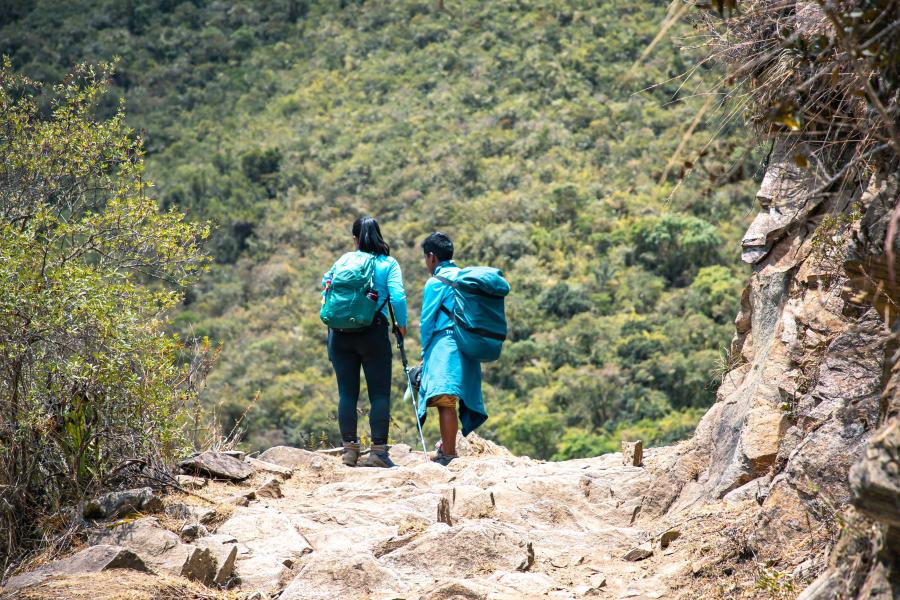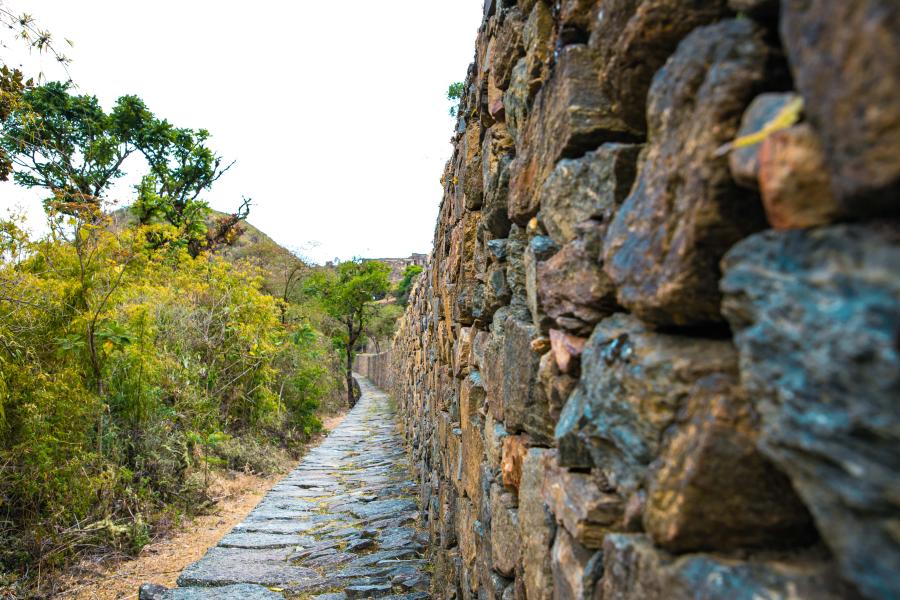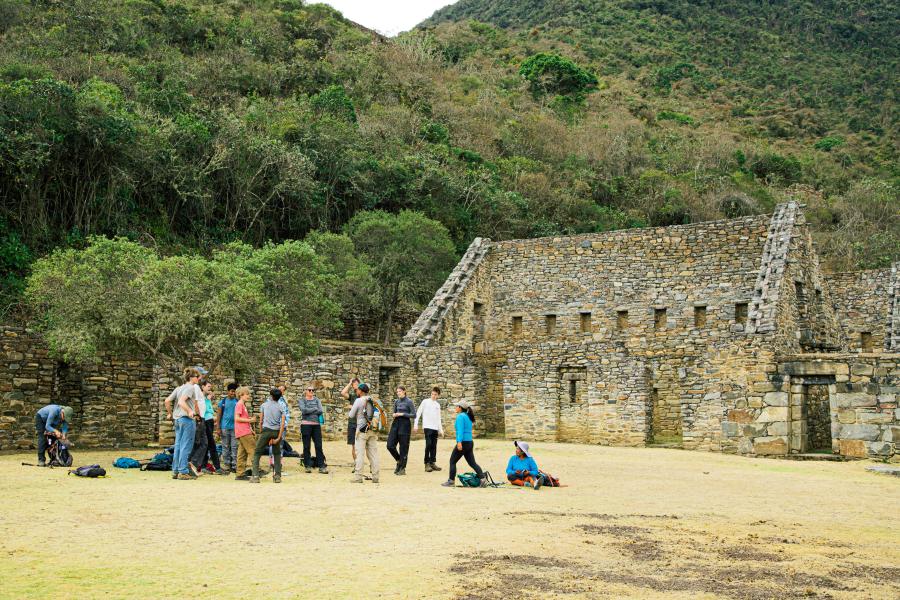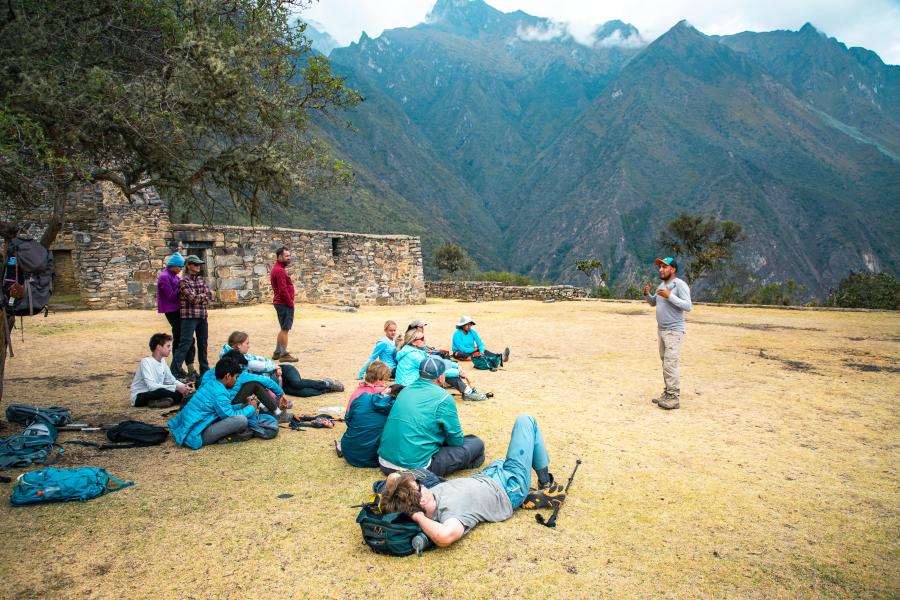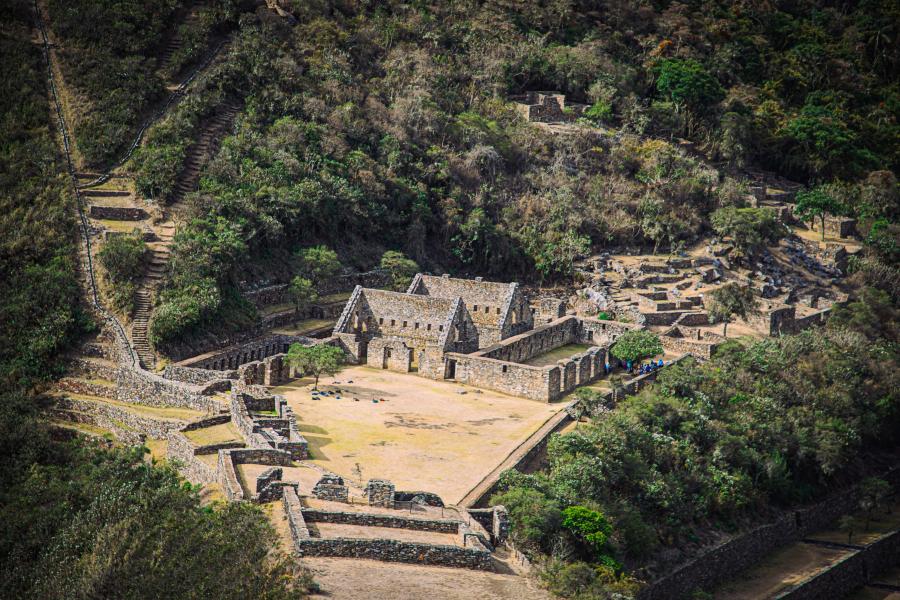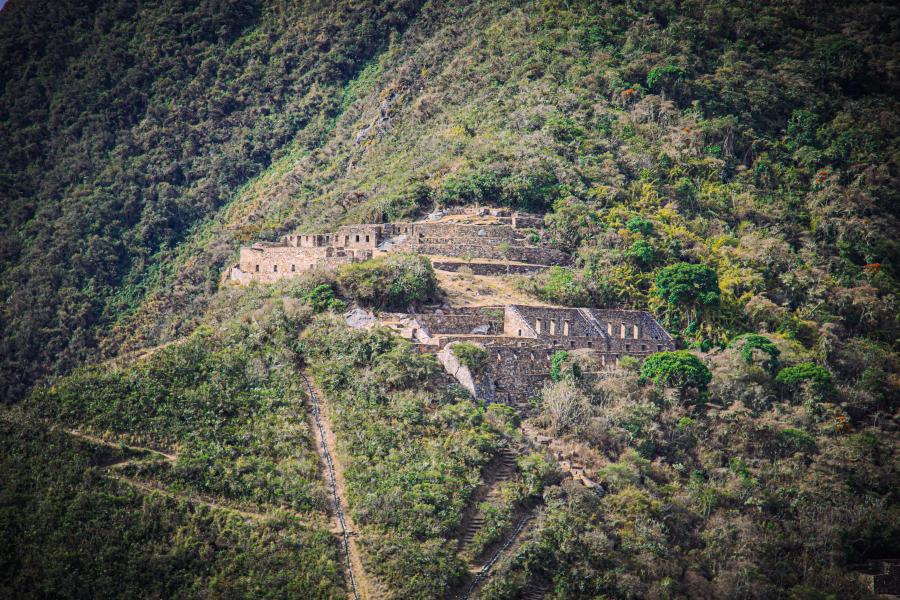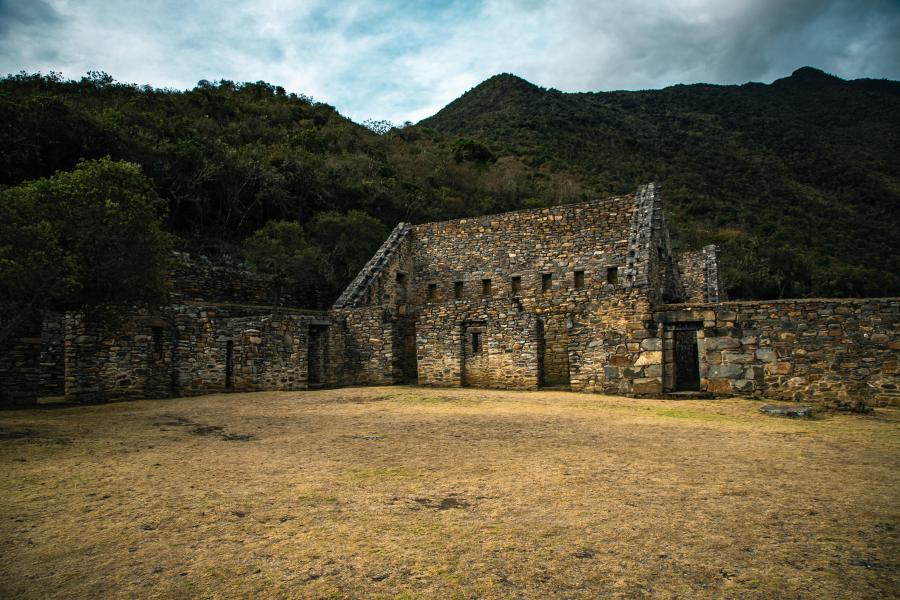Embark on an amazing 6-day adventure on the Choquequirao Trek to Machu Picchu. This trek takes you to the hidden Inca site of Choquequirao, known as the "Sister of Machu Picchu." Hike through beautiful valleys, climb mountain passes, and enjoy stunning views.
Discover the rich history and culture of the Incas as you make your way to the breathtaking Machu Picchu. This journey is a perfect blend of nature and history, offering an unforgettable experience for all adventurers.
Overview
Choquequirao Trek to Machu Picchu 6 Days
Embark on a 6-day hiking adventure from the remote Incan ruins of Choquequirao to the world-famous Machu Picchu in Peru. Choquequirao, meaning "cradle of gold" in Quechua, is a hidden gem high in the Andes Mountains. This trek is challenging but immensely rewarding.
Tour Highlights:
- Explore the secluded Inca site of Choquequirao.
- Marvel at the stunning Andes Mountains and Apurimac Canyon views.
- Enjoy a scenic train ride through the Sacred Valley to Machu Picchu.
- Participate in a traditional Pachamanca Barbecue.
- Book with confidence and flexibility.
Day by Day Summary
Day 1: Cusco – Capuliyoc – Chikiska Begin with a 4:30 am pickup from Cusco and a 4-hour drive to Capuliyoc (2950 m/9678 ft). After a picnic breakfast, start a 4-hour downhill hike into the Apurimac Canyon, camping at Chikiska (1950 m/6398 ft).
Day 2: Chikiska – La Playa Rosalina – Marampata Wake up early with coffee or coca tea, then hike for 6 hours to Marampata camp (2940 m/9646 ft) after breakfast.
Day 3: Discover Choquequirao – Marampata Enjoy a hearty breakfast before a 2-hour hike to Choquequirao. Spend the day exploring this impressive Inca site and learning about its history.
Day 4: Marampata – Playa – Coca Masana After soaking in breathtaking views, hike 4 hours to Playa Rosalina and another 2 hours uphill to Coca-Masana campsite (2330 m/7545 ft).
Day 5: Coca Masana – Capuliyoc – Ollantaytambo – Aguas Calientes Start the day with a 4-hour uphill hike to Capuliyoc pass, followed by lunch and a 4-hour drive to Ollantaytambo. Board the expedition train to Aguas Calientes and spend the night in a hotel.
Day 6: Explore Machu Picchu – Return to Cusco After an early breakfast, catch the first bus to Machu Picchu for a guided tour. You can also hike Huayna Picchu or Machu Picchu Mountain. In the afternoon, take the Vistadome Panoramic Train back to Cusco.
Your adventure begins in Cusco, with a 4:30 am hotel pick-up. You’ll drive for about 4 hours to the small town of Capuliyoc, passing charming villages and enjoying breathtaking views of the Andes Mountains. Upon arrival, you’ll meet your trekking team, have breakfast, and start the hike to Chikiska Campsite.
The trail descends from Capuliyoc at 2950 m (9678 ft) to Chikiska at 1950 m (6398 ft). The 10-kilometer (6.2 miles) hike takes around 4 hours, mostly downhill.
As you trek through a canyon, you’ll be treated to stunning views of the mountains and valleys. The Chikiska campsite, nestled in a lush valley, offers magnificent mountain views. Once at the campsite, you’ll have time to relax, enjoy dinner, and settle into your tent for the night. This challenging yet rewarding first day sets the stage for the amazing scenery and wildlife ahead.
Wake up in your tent with a hot cup of coffee or coca tea to start the day. After packing up, enjoy an early breakfast at the campsite. The trek begins with a hike to the small village of Santa Rosa, located at 2300 m (7500 ft). This part of the hike is mostly uphill, through lush vegetation, offering beautiful mountain views and opportunities to spot birdlife, including the majestic Andean condor.
Upon reaching Santa Rosa, take a break for lunch before continuing to Marampata, situated at 2940 m (9646 ft). The trail to Marampata, which takes about 3-4 hours, leads you through a cloud forest with stunning views of the Apurimac River.
Arriving in Marampata, set up camp, have dinner, and settle into your tent for the night. The campsite at Marampata boasts spectacular views of the surrounding mountains, making it a perfect end to the day's journey.
Day 3's highlight is visiting the remote Inca Citadel of Choquequirao. After breakfast, embark on a hike to the ruins, located at 3050 m (10,006 ft). The 2-3 hour trail covers around 3 kilometers (1.8 miles) and is both challenging and rewarding, offering breathtaking views of the surrounding mountains and valleys.
At Choquequirao, explore the extensive ruins and delve into Incan history and culture. Spanning approximately 1,800 hectares (4,500 acres), Choquequirao was likely a significant religious and administrative center during the Incan empire.
The well-preserved ruins provide insight into the Incas' remarkable engineering skills. Key sites include the Main Plaza, the Temple of the Sun, and the House of the Waterfalls. You'll also learn about the Incan farming practices and irrigation systems that enabled them to thrive in this remote location.
After exploring Choquequirao, hike back to Marampata, where you'll have dinner and spend the night in your tent. This day, filled with exploration of the awe-inspiring Choquequirao ruins, is often the trek's highlight, offering an unforgettable glimpse into the Incan civilization in a spectacular setting.
After breakfast, you'll embark on a hike from Marampata to Coca Masana, passing through the small town of La Playa. Start your day with an early breakfast at the Marampata campsite before descending towards the Apurimac River. The trail winds through a cloud forest, past small villages, and offers breathtaking mountain views. After approximately 3 hours of hiking, you'll reach La Playa, where you'll pause for lunch.
Post-lunch, continue your hike towards Coca Masana. This part of the trail takes around 2 hours and continues to provide beautiful vistas of the Andes Mountains.
Upon arrival at Coca Masana, set up camp and enjoy dinner. The campsite, situated near the Apurimac River, offers stunning mountain views, making it a perfect spot to relax after a day's hike.
Begin your day with an early breakfast at the Coca Masana campsite before starting the hike back up to Capuliyoc, situated at 2950 m (9678 ft). The ascent takes around 3 hours and offers stunning views of the surrounding mountains and valleys.
Upon reaching Capuliyoc, enjoy a special Pachamanca barbecue lunch. Afterward, you'll embark on a 4-hour car journey to Ollantaytambo, a charming town in the Sacred Valley.
From Ollantaytambo, board a train to Aguas Calientes, the town at the base of Machu Picchu. Upon arrival, have dinner and settle into your accommodation for the night, preparing for the final day's adventure.
On the final day, you'll visit the iconic Machu Picchu. Start with an early breakfast in Aguas Calientes before taking a bus up to Machu Picchu, located at 2,430 m (7,970 ft).
Upon arrival, you'll explore the famous Citadel and learn about Incan history and culture. Built in the 15th century, Machu Picchu is a UNESCO World Heritage Site. Key sites include the Main Plaza, the Temple of the Sun, and the Intihuatana.
Your guide will share insights and historical details, and you'll also have time to explore on your own, enjoying the stunning mountain and valley views. After the visit, take a bus back to Aguas Calientes, have lunch, and then board the Vistadome Panoramic Train to Ollantaytambo. From there, a private van will take you back to Cusco, with an expected arrival time around 7:30 pm.
Included:
Safety briefing the day before the tour
Hotel pick-up and drop-off
All transportation for the 6-day trek
Professional, English-speaking guide
Camping gear
Dining and kitchen equipment
All meals during the trek
Snacks
Potable water during the trek
Entrance fees to Choquequirao and Machu Picchu
Train tickets from Ollantaytambo to Aguas Calientes
Vistadome Panoramic train tickets for the return journey
4 nights of camping
One night at a 3-star hotel in Aguas Calientes
Bus tickets to and from Machu Picchu
All taxes and booking fees
Not included:
Flights to and from Cusco
Accommodation in Cusco before and after the trek
Travel insurance
Tips for guides, cooks, and porters
Personal expenses, like souvenirs and additional snacks
Lunch on the last day in Aguas Calientes
What is the Choquequirao Trek to Machu Picchu and why should I choose it?
The Choquequirao Trek to Machu Picchu is a 6-day hiking adventure through the Andes Mountains in Peru. This trek connects two significant Incan sites: the remote ruins of Choquequirao and the famous Machu Picchu. Choquequirao, known as the "Cradle of Gold," offers a less crowded experience compared to Machu Picchu, making it ideal for those seeking solitude and adventure. The trek takes you through breathtaking landscapes, diverse ecosystems, and offers a deep dive into the history and culture of the Incas. If you are looking for a challenging hike with stunning scenery and historical significance, this trek is perfect for you.
How challenging is the Choquequirao Trek and what level of fitness is required?
The Choquequirao Trek is considered challenging due to its steep ascents and descents, high altitudes, and long hiking days. You will need good physical fitness to handle the demands of the trek. It is recommended to prepare by doing regular cardio workouts, such as running or cycling, and incorporating strength training exercises. Practicing long-distance walking and stair climbing will also help. The trek involves hiking for 6-8 hours a day, often on uneven and rocky terrain. Prior hiking experience is beneficial, but with proper preparation, most people in good health can complete the trek.
When is the best time of year to hike the Choquequirao Trek?
The best time to hike the Choquequirao Trek is during the dry season, which runs from May to October. During these months, the weather is more stable, with clear skies and lower chances of rain. This makes the trails safer and more enjoyable to hike. The dry season also offers better visibility, allowing you to fully appreciate the stunning landscapes and views. While the dry season is ideal, it is also the most popular time, so booking your trek in advance is recommended. The rainy season, from November to April, can make the trails muddy and slippery, adding to the difficulty of the trek.
How do I get to the starting point of the trek from Cusco?
To reach the starting point of the trek from Cusco, you will typically take a drive to the small town of Capuliyoc. The drive takes about 4 hours and passes through beautiful Andean landscapes and small villages. From Capuliyoc, you will begin your hike towards Choquequirao. Many tour operators offer transportation as part of their trekking packages, making it convenient to get to the starting point. If you are traveling independently, you can hire a taxi or arrange for private transport from Cusco to Capuliyoc.
Do I need any special permits or tickets for the trek?
Yes, you need special permits to enter Choquequirao and Machu Picchu. These permits are usually arranged through your tour operator or can be purchased at the entry points. It is recommended to book your permits in advance, especially during peak seasons, to ensure availability. Having the necessary permits will allow you to legally enter and explore these historical sites. Additionally, having some cash on hand for entry fees and local expenses is advisable, as card payments may not always be accepted.
What kind of weather can I expect during the trek?
During the dry season, you can expect clear skies, warm days, and cool nights. Daytime temperatures usually range from 15-25°C (59-77°F), while nighttime temperatures can drop to 0-10°C (32-50°F). It’s important to be prepared for sudden weather changes, especially at higher altitudes. Layers are key, as they allow you to adjust to the varying temperatures. Rain is less common during the dry season but can still occur, so having a waterproof jacket is essential. The weather can greatly impact your trekking experience, so being prepared for all conditions is crucial.
What essential gear and clothing should I pack for the trek?
Packing the right gear is crucial for a successful trek. Here’s a detailed list of essentials:
1. Clothing: Bring layered clothing to handle varying temperatures. This includes moisture-wicking shirts, thermal layers, a warm jacket, and a raincoat. Don’t forget a hat and gloves for cold mornings and evenings.
2. Footwear: Sturdy, broken-in hiking boots with good ankle support are essential to protect your feet and ankles on the rocky terrain.
3. Camping Gear: A high-quality tent, a sleeping bag rated for cold temperatures, and a comfortable sleeping mat are necessary if not provided by your tour operator.
4. Food and Water: Carry enough water or have a purification system, such as water purification tablets or a portable water filter. Bring high-energy snacks like nuts, dried fruits, and energy bars.
5. First Aid Kit: Include bandages, antiseptic, blister treatment, pain relievers, and any personal medications you may need.
6. Other Essentials: Sunscreen, insect repellent, a headlamp with extra batteries, trekking poles, a backpack, and a waterproof cover for your backpack.
How long is the Choquequirao Trek and how many hours will I be hiking each day?
The Choquequirao Trek is approximately 60 kilometers (37 miles) long and typically takes 6 days to complete. Each day involves hiking for 6-8 hours, depending on the terrain and your pace. The trek includes both uphill and downhill sections, with significant elevation changes. The daily distances and hiking times can vary, but you can expect to cover around 10-15 kilometers (6-9 miles) each day. The trek is physically demanding, but the stunning scenery and historical sites make it a rewarding experience.
What are the accommodation options during the trek?
Accommodation during the trek is usually in tents at designated campsites. These campsites are basic but located in beautiful natural settings. Some tour operators provide camping equipment and set up the campsites for you, making it more convenient. Be prepared for rustic conditions and bring a comfortable sleeping mat and warm sleeping bag. The campsites offer a chance to rest and enjoy the serene environment after a long day of hiking. Occasionally, you might camp near small villages where you can interact with local communities.
Is there clean drinking water available on the trek?
While there are natural water sources along the trek, it’s essential to treat the water before drinking. Carry water purification tablets or a portable water filter to ensure you have safe drinking water. Your tour operator may also provide treated water at campsites. It’s important to stay hydrated, especially at high altitudes, so make sure you have a reliable method for purifying water. Drinking untreated water can lead to illness, which can severely impact your trekking experience.
What type of food will be provided during the trek?
If you book a guided tour, meals are typically provided and include nutritious, energy-rich foods suitable for trekking. Expect a mix of local and international cuisine, including soups, pasta, rice, vegetables, and meats. High-energy snacks like nuts, fruits, and granola bars are also commonly provided. The meals are designed to provide the necessary energy for the strenuous hikes. If you have dietary restrictions or preferences, inform your tour operator in advance so they can accommodate your needs.
What are the main highlights and must-see spots along the trek?
Key highlights of the Choquequirao Trek include the Main Plaza, the Temple of the Sun, and the House of the Waterfalls at Choquequirao. The trek also offers stunning views of the Andes, the Apurimac River, and diverse landscapes. The final destination, Machu Picchu, is the most famous highlight, offering iconic ruins and breathtaking scenery. Along the way, you’ll also pass through lush valleys, cloud forests, and small Andean villages, each with its unique charm and beauty. The combination of natural beauty and historical significance makes this trek an unforgettable experience.
How can I prevent and handle altitude sickness during the trek?
Altitude sickness can affect anyone, regardless of fitness level. To prevent altitude sickness, spend a few days in Cusco to acclimate before starting the trek. Stay hydrated, ascend slowly, and avoid alcohol and strenuous activity in the first few days. If symptoms like headaches, nausea, or dizziness occur, descend to a lower altitude immediately. Medications like acetazolamide (Diamox) can also help. It’s important to listen to your body and take necessary precautions to ensure a safe and enjoyable trek.
Is it necessary to hire a guide or can I trek independently?
While it is possible to trek independently, hiring a guide is highly recommended for safety, logistical support, and enhanced cultural insights. Guides are familiar with the terrain, can assist in emergencies, and provide valuable information about the historical and cultural significance of the sites. They also handle permits and logistics, allowing you to focus on enjoying the trek. Independent trekking requires thorough preparation and experience with high-altitude hikes. For most travelers, a guided trek offers a more enriching and stress-free experience.
What safety precautions should I take while hiking?
Safety is paramount on the Choquequirao Trek. Stick to marked trails, watch your step on rocky paths, and be cautious around river crossings. Stay hydrated, wear appropriate clothing and footwear, and carry a first aid kit. Hiring a guide can significantly enhance your safety. Always inform someone of your travel plans and expected return time. Be aware of your surroundings and avoid hiking alone, especially in remote areas. Keeping these safety tips in mind will help ensure a safe and enjoyable trek.
How do I prepare physically and mentally for the trek?
Physical preparation should include cardio workouts, stair climbing, and endurance training. Strength training can also help build the muscle needed for steep ascents and descents. Mentally, prepare by researching the trek, understanding the challenges, and setting realistic expectations. Practicing mindfulness and staying positive can help you handle the trek’s demands. It’s also helpful to practice hiking with a loaded backpack to simulate the conditions of the trek. Preparing both physically and mentally will enhance your overall trekking experience.
What should I know about the cultural and historical significance of Choquequirao and Machu Picchu?
Choquequirao and Machu Picchu were significant Incan sites, serving as ceremonial and administrative centers. Choquequirao, often called the "Cradle of Gold," showcases advanced engineering and agricultural practices. Machu Picchu, a UNESCO World Heritage Site, is renowned for its architectural brilliance and historical importance. Understanding the cultural and historical context of these sites adds depth to your trekking experience. Learning about the Incan civilization, their achievements, and their way of life will enrich your visit to these ancient ruins.
Are there opportunities to see wildlife along the trek?
Yes, the Choquequirao Trek offers opportunities to see diverse wildlife, including Andean condors, hummingbirds, spectacled bears, and various species of flora. The cloud forests and mountainous regions are rich in biodiversity, providing a unique experience for nature enthusiasts. Keep your eyes open for these animals and enjoy the natural beauty of the Andes. Birdwatching can be particularly rewarding, with many species endemic to the region. Respect the wildlife and maintain a safe distance to avoid disturbing their natural habitat.
What are the options for transportation from Aguas Calientes back to Cusco?
After visiting Machu Picchu, you can take the train from Aguas Calientes to Ollantaytambo. The train ride offers scenic views of the Sacred Valley, making it a pleasant end to your journey. From Ollantaytambo, you can take a bus or private transport back to Cusco. Many tour operators include transportation in their packages, ensuring a smooth transition from Machu Picchu to Cusco. It’s recommended to book your return transport in advance, especially during peak travel seasons.
Travel Info
Choquequirao, The Cradle of Gold
Choquequirao, meaning "Cradle of Gold" in Quechua, is a hidden gem nestled high in the Andes Mountains of Peru. This remote Incan site is often referred to as the "Sister of Machu Picchu" due to its similar architecture and impressive terraces. Unlike Machu Picchu, Choquequirao remains largely unexplored by tourists, offering a serene and immersive experience. The site spans an area of approximately 1,800 hectares (4,500 acres) and features a variety of structures, including temples, plazas, and agricultural terraces.
Historical Significance
Choquequirao played a crucial role during the Incan Empire as a ceremonial and administrative center. It is believed to have been a place of refuge for the Incas during the Spanish Conquest. The site is a testament to the advanced engineering and agricultural practices of the Incas, showcasing their ability to thrive in the challenging Andean environment. The intricate stonework, extensive terraces, and sophisticated irrigation systems highlight the ingenuity and resilience of this ancient civilization.
Why Visit Choquequirao?
Visiting Choquequirao offers a unique blend of adventure, history, and natural beauty. The trek to Choquequirao is challenging but immensely rewarding, providing hikers with stunning views of the Andes, diverse wildlife, and an opportunity to experience Incan history away from the crowds. The sense of solitude and connection to nature makes this trek a once-in-a-lifetime experience.
Best Time to Visit
The best time to visit Choquequirao is during the dry season, which runs from May to October. During these months, the weather is more stable, with clear skies and lower chances of rain, making the trek safer and more enjoyable. The dry season also offers better visibility of the breathtaking landscapes and archaeological sites.
How to Get There
The journey to Choquequirao typically begins in Cusco, the historic capital of the Incan Empire. From Cusco, you can take a 4-hour drive to the small town of Capuliyoc, where the trek begins. The hike to Choquequirao usually takes 4-5 days round trip, covering diverse terrains, including lush valleys, cloud forests, and steep mountain paths. The trek is demanding, so it's important to be well-prepared and physically fit.
Permits and Fees
To visit Choquequirao, you'll need to obtain the necessary permits. These permits can usually be arranged through tour operators or purchased at the entry point. It's advisable to book in advance, especially during peak season, to secure your spot. Additionally, have some cash on hand to pay for any fees and local expenses along the way.
Highlights and Must-See Spots
Key highlights of Choquequirao include the Main Plaza, the Temple of the Sun, and the House of the Waterfalls. The site also boasts impressive agricultural terraces that descend the steep mountain slopes. These terraces were used for farming and are a testament to the Incas' advanced agricultural techniques. The panoramic views from the terraces and other vantage points are breathtaking, offering a glimpse into the natural beauty of the Andes.
Physical Fitness and Training
The trek to Choquequirao is physically demanding, requiring good physical fitness and stamina. It's important to prepare by engaging in regular cardio workouts, stair climbing, and long-distance walking. Strength training exercises can also help build the endurance needed for the steep ascents and descents along the trail. Ensure you are in good health and consult with a doctor if you have any pre-existing medical conditions.
Essential Gear and Packing List
Packing the right gear is crucial for a successful trek. Here’s a list of essentials:
- Clothing: Layered clothing for varying temperatures, including moisture-wicking shirts, thermal layers, a warm jacket, and a raincoat.
- Footwear: Sturdy, broken-in hiking boots with good ankle support.
- Camping Gear: A good quality tent, sleeping bag rated for cold temperatures, and a comfortable sleeping mat.
- Food and Water: Sufficient water or a purification system, high-energy snacks, and meal planning if not provided by your tour.
- First Aid Kit: Bandages, antiseptic, blister treatment, and personal medications.
- Other Essentials: Hat, sunglasses, sunscreen, insect repellent, and trekking poles.
Altitude Acclimatization
Altitude acclimatization is essential to avoid altitude sickness, which can affect even the fittest individuals. Spend a few days in Cusco or another high-altitude location before starting your trek. Symptoms of altitude sickness include headaches, nausea, dizziness, and fatigue. To prevent it, ascend gradually, stay hydrated, and avoid alcohol and strenuous activity in the first few days.
What to Expect on the Trail
The trail to Choquequirao includes diverse terrains, from steep, rocky paths to lush cloud forests. You’ll trek through scenic valleys, cross rivers, and pass by small Andean villages. The journey is physically demanding but offers stunning views of the surrounding mountains and valleys. Be prepared for changing weather conditions and carry a rain jacket and warm clothing.
Campsites and Accommodation
Campsites along the trail are usually basic but located in beautiful natural settings. Make sure you have a comfortable tent and sleeping gear. Some tours provide camping equipment and set up campsites for you. Enjoy the serene environment, clear skies, and the sounds of nature as you rest and prepare for the next day’s hike.
Food and Water on the Trek
Ensure you carry enough water or have a purification system, as drinkable water sources may be limited. Bring high-energy snacks like nuts, dried fruits, and energy bars to keep your energy levels up. If meals are not provided by your tour, plan simple and nutritious meals that are easy to prepare and carry.
Altitude Sickness Prevention
Prevent altitude sickness by staying hydrated, ascending slowly, and taking rest days to acclimate. If you experience symptoms, descend to a lower altitude immediately and seek medical attention if necessary. Carry medications like acetazolamide (Diamox) as a precaution.
Staying Safe on the Trail
Safety is paramount on the trek. Stick to marked trails, watch your step on rocky paths, and be cautious around river crossings. Hiring a guide can enhance your safety and provide valuable local knowledge and support in case of emergencies.
Main Attractions within the Citadel
Explore the Main Plaza, where ceremonies and gatherings were held. Visit the Temple of the Sun, an important religious site, and the House of the Waterfalls, which showcases the Incas' impressive water management system. The site’s terraces, used for agriculture, offer a glimpse into the advanced farming techniques of the Incas.
Guided Tours vs. Independent Exploration
Choosing between a guided tour and independent exploration depends on your preferences. Guided tours provide historical insights, logistical support, and enhanced safety. Independent exploration allows more flexibility and a personal sense of discovery. Regardless of your choice, respect the site and follow guidelines to preserve its integrity.
Photography Tips
Capture the beauty of Choquequirao with your camera. Early morning or late afternoon light offers the best conditions for photography. Focus on the intricate stonework, the vast terraces, and the stunning landscapes. Remember to respect the site and avoid climbing on fragile structures.
Leave No Trace Principles
Follow the "Leave No Trace" principles to minimize your impact on the environment. Pack out all trash, stay on marked trails, and avoid disturbing wildlife and plants. Leave the site as you found it to preserve its beauty for future generations.
Supporting Local Conservation Efforts
Support local conservation efforts by respecting the environment and contributing to the local economy through responsible tourism practices. Choose eco-friendly tours and accommodations that prioritize sustainability and environmental protection.
Sustainable Travel Tips
Use reusable water bottles, avoid single-use plastics, and choose eco-friendly products. Support local businesses, buy local produce, and minimize your environmental footprint. Be a responsible traveler and advocate for sustainable tourism practices.
Recommendations for Future Travelers
- Plan and Prepare Thoroughly: Research the trek, prepare your gear, and ensure you are physically and mentally ready for the challenge.
- Respect Local Customs and Communities: Engage respectfully with local communities, learn about their culture, and follow their customs.
- Be Mindful of the Environment: Follow eco-friendly practices, respect wildlife, and leave no trace.
- Enjoy the Journey: Embrace the adventure, take in the stunning views, and savor the unique experience of exploring Choquequirao, the Cradle of Gold.

